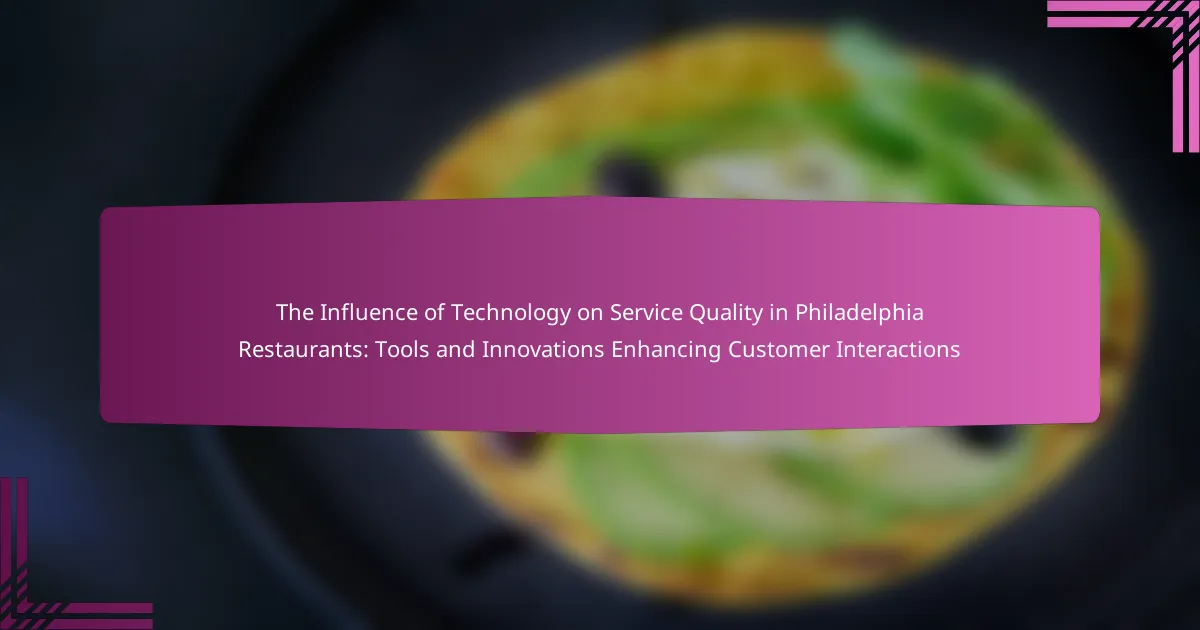
How does menu variety impact service quality in Philadelphia restaurants?
Menu variety positively impacts service quality in Philadelphia restaurants. A diverse menu allows for greater customer choice, enhancing satisfaction. Customers appreciate having options that cater to different tastes and dietary needs. This variety can lead to increased customer loyalty and repeat visits. Studies show that restaurants with extensive menus often receive higher ratings for service quality. For instance, a survey by the National Restaurant Association indicated that 70% of diners prefer restaurants with a wide selection. This preference influences the overall dining experience, as customers feel valued when their preferences are considered.
What factors contribute to the relationship between menu variety and service quality?
Menu variety significantly influences service quality in restaurants. A diverse menu can enhance customer satisfaction by catering to varied tastes and dietary preferences. When customers find appealing options, they are more likely to have a positive dining experience. This positive experience often translates to higher service quality perceptions.
Additionally, a well-curated menu can streamline service efficiency. Staff can become more familiar with a focused selection, improving their ability to make recommendations and respond to customer queries. Research indicates that restaurants with extensive, well-organized menus often receive higher ratings for service quality.
Moreover, menu variety can contribute to repeat business. Customers who enjoy their experience are likely to return, thereby increasing overall service quality through familiarity. In summary, factors such as customer satisfaction, service efficiency, and repeat business contribute to the relationship between menu variety and service quality.
How does menu variety influence customer satisfaction?
Menu variety significantly influences customer satisfaction. A diverse menu caters to different tastes and dietary preferences. This variety increases the likelihood of customers finding appealing options. Research indicates that restaurants with extensive menus receive higher satisfaction ratings. A study by Kwortnik and Thompson (2009) found that menu diversity enhances perceived quality. Customers appreciate having choices, which leads to a more enjoyable dining experience. Limited options can result in dissatisfaction and reduced repeat visits. Therefore, offering a varied menu is essential for maximizing customer satisfaction in restaurants.
What role does staff training play in service quality with diverse menus?
Staff training significantly enhances service quality when managing diverse menus. Trained staff possess a deep understanding of menu items. This knowledge enables them to provide accurate recommendations to customers. Additionally, training improves staff confidence in handling customer inquiries. Well-trained employees can efficiently manage dietary restrictions and preferences. This responsiveness leads to higher customer satisfaction. Research indicates that restaurants with comprehensive staff training report better service ratings. For instance, a study by the National Restaurant Association found that 70% of diners value knowledgeable staff. Thus, effective staff training directly correlates with improved service quality in diverse menu settings.
Why is understanding customer preferences crucial for restaurant success?
Understanding customer preferences is crucial for restaurant success because it directly influences menu design and customer satisfaction. Restaurants that align their offerings with customer tastes tend to attract and retain more patrons. A study by the National Restaurant Association found that 70% of consumers are more likely to choose a restaurant that offers a variety of menu options that cater to their preferences. Additionally, understanding these preferences helps in tailoring marketing strategies, leading to increased sales and customer loyalty. By analyzing customer feedback and dining trends, restaurants can adapt their menus to meet evolving demands, ensuring they remain competitive in the market.
What are the key preferences of Philadelphia restaurant patrons?
Philadelphia restaurant patrons prefer diverse menu options. They seek a variety of cuisines, reflecting the city’s multicultural landscape. Health-conscious choices are increasingly important for many diners. Locally sourced ingredients also appeal to patrons who value sustainability. Price sensitivity plays a role in dining decisions, with many seeking value for their money. Dining atmosphere significantly influences preferences, with a focus on comfort and ambiance. Customer service quality is crucial; patrons appreciate attentive and friendly staff. Lastly, online reviews and recommendations heavily impact restaurant choices.
How do cultural influences shape menu choices among customers?
Cultural influences significantly shape menu choices among customers. These influences dictate food preferences, ingredient selections, and dining practices. For instance, individuals from Asian cultures may favor rice-based dishes, while Mediterranean customers might prefer olive oil and fresh vegetables. Furthermore, cultural traditions often dictate meal times and social dining practices. Research indicates that cultural backgrounds affect perceptions of flavor, texture, and presentation. A study published in the Journal of Culinary Science & Technology highlights how cultural familiarity can enhance the dining experience. This demonstrates that understanding cultural influences is crucial for restaurants to cater effectively to diverse customer preferences.

What insights can be gained from analyzing customer experiences in Philadelphia restaurants?
Analyzing customer experiences in Philadelphia restaurants reveals key insights into service quality and menu preferences. Understanding customer feedback helps identify areas for improvement in dining experiences. Data from reviews indicate that diverse menu options enhance customer satisfaction. Restaurants with varied menus often receive higher ratings for service quality. Specific preferences for local cuisine can influence menu design. Additionally, customer experiences highlight the importance of attentive service in shaping overall satisfaction. Trends in dining behaviors can inform restaurant strategies for better engagement. Such insights can guide restaurant owners in optimizing their offerings and improving customer loyalty.
How do customers perceive menu variety in relation to their dining experience?
Customers perceive menu variety as a significant factor in their dining experience. A diverse menu enhances customer satisfaction and engagement. It allows diners to explore different flavors and cuisines. Research shows that 70% of customers prefer restaurants with extensive menus. This variety can lead to increased patronage and repeat visits. Customers often associate menu variety with higher quality and better service. A well-curated menu can cater to diverse dietary preferences. This inclusivity fosters a positive atmosphere and enhances overall dining enjoyment.
What feedback do customers provide about menu options and service interactions?
Customers often provide feedback indicating a strong preference for diverse menu options. Many appreciate when restaurants offer seasonal dishes and local ingredients. This variety enhances their dining experience and encourages repeat visits.
Service interactions are also a significant focus in customer feedback. Patrons frequently comment on the attentiveness and knowledge of staff regarding menu items. Positive interactions can elevate the overall dining experience, leading to higher satisfaction ratings.
Conversely, customers express dissatisfaction when menu options are limited or when servers lack product knowledge. These factors can negatively impact their perception of the restaurant. In summary, diverse menu options and quality service interactions are crucial for customer satisfaction in Philadelphia restaurants.
How does menu variety affect repeat business and customer loyalty?
Menu variety significantly influences repeat business and customer loyalty. A diverse menu caters to different tastes and dietary needs. This variety encourages customers to return, as they can explore new options during each visit. Research indicates that 60% of customers prefer restaurants with extensive menus. A broader selection often leads to higher satisfaction levels. Satisfied customers are more likely to become repeat patrons. Furthermore, unique dishes can create memorable dining experiences. These experiences foster emotional connections with the restaurant brand. Ultimately, menu variety is a crucial factor in building long-term customer relationships.
What challenges do restaurants face when offering a varied menu?
Restaurants face several challenges when offering a varied menu. One major challenge is inventory management. A diverse menu requires a larger variety of ingredients, complicating stock control. This can lead to increased food waste if items are not used before expiration. Another challenge is staff training. Employees must be knowledgeable about a wide range of dishes, which can be time-consuming and costly. Additionally, maintaining consistency in food quality becomes more difficult with a varied menu. Customers expect the same high standard across all offerings. Furthermore, operational efficiency can suffer. Preparing multiple dishes can slow down service times, impacting customer satisfaction. Lastly, pricing strategies become complex. Restaurants must balance ingredient costs with customer expectations for value. These challenges collectively influence the overall service quality and customer experience in restaurants.
How can operational efficiency be maintained with an extensive menu?
Operational efficiency can be maintained with an extensive menu by implementing streamlined processes. Standardizing recipes reduces preparation time and training costs. Utilizing technology, such as inventory management systems, helps track ingredient usage efficiently. Staff training focused on multitasking can enhance service speed. Menu engineering, by analyzing sales data, can identify popular items to promote. Regularly reviewing and updating the menu keeps it relevant and manageable. These strategies collectively ensure that operational efficiency is upheld despite a diverse menu offering.
What strategies can restaurants employ to balance variety and quality?
Restaurants can balance variety and quality by implementing focused menu design. They can curate a limited selection of dishes that highlight seasonal ingredients. This approach enhances freshness and allows for higher quality preparation.
Additionally, restaurants can rotate menu items regularly to maintain variety without compromising quality. This strategy keeps the offerings dynamic and exciting for customers.
Training staff to emphasize key dishes can also help maintain quality while providing variety. Staff can recommend signature items that showcase the restaurant’s strengths.
Using customer feedback to refine the menu can further enhance this balance. Regularly assessing customer preferences ensures that the menu aligns with their tastes while maintaining quality standards.
Research indicates that a well-structured menu can lead to improved customer satisfaction. A study by Kwortnik and Thompson (2009) found that variety in menu offerings positively influences perceived service quality.

How can restaurants optimize their menu variety to enhance service quality?
Restaurants can optimize their menu variety by analyzing customer preferences and incorporating diverse options. This approach allows them to cater to various dietary needs and tastes. Offering seasonal items can also enhance freshness and appeal. Research indicates that a well-balanced menu can improve customer satisfaction. A study by the National Restaurant Association found that 75% of diners consider menu variety important. Additionally, using customer feedback can guide menu adjustments. Regularly updating the menu keeps it exciting and relevant. This strategy ultimately leads to improved service quality and repeat business.
What best practices should restaurants follow in menu design?
Restaurants should prioritize clarity, organization, and visual appeal in menu design. Clear headings and categories help customers navigate easily. Descriptive item names engage customer interest and enhance understanding. A logical flow from appetizers to desserts creates a seamless experience. Visual elements, such as images or icons, can attract attention to specific dishes. Consistent font styles and sizes improve readability. Limiting the number of items can reduce decision fatigue. Research shows that well-designed menus can increase sales by up to 15% (Source: Cornell University, “The Impact of Menu Design on Sales”).
How can seasonal ingredients influence menu variety and customer engagement?
Seasonal ingredients enhance menu variety and boost customer engagement. They introduce fresh flavors and unique dishes that reflect the time of year. This change keeps the menu exciting and encourages repeat visits. Customers often seek new experiences, and seasonal items can create a sense of urgency. Research shows that 70% of diners are more likely to visit a restaurant that offers seasonal dishes. Seasonal ingredients can also support local farmers, appealing to customers who value sustainability. This connection to local sourcing can strengthen customer loyalty and community ties. Overall, utilizing seasonal ingredients can significantly improve a restaurant’s appeal and customer interaction.
What role does customer feedback play in menu adjustments?
Customer feedback plays a crucial role in menu adjustments. Restaurants use feedback to identify popular and unpopular dishes. This information helps in optimizing menu offerings. Adjustments based on feedback can enhance customer satisfaction. For example, a survey by the National Restaurant Association found that 70% of patrons prefer a menu that reflects their preferences. By analyzing this data, restaurants can make informed decisions about which items to keep or remove. This process ultimately leads to improved service quality and better dining experiences.
What are practical tips for improving service quality through menu variety?
Offering a diverse menu can significantly enhance service quality. A varied menu caters to different dietary preferences and restrictions. This inclusivity can lead to higher customer satisfaction. Regularly updating the menu keeps the offerings fresh and exciting. Seasonal ingredients can be highlighted to enhance flavor and appeal. Staff training on menu items improves their ability to recommend dishes. Utilizing customer feedback can guide future menu changes. Lastly, clear menu descriptions help customers make informed choices quickly.
How can staff be trained to handle diverse menu items effectively?
Staff can be trained to handle diverse menu items effectively through structured training programs. These programs should include detailed product knowledge sessions about each menu item. Staff should learn about ingredients, preparation methods, and presentation styles. Role-playing scenarios can enhance their ability to recommend dishes based on customer preferences. Regular tastings will familiarize staff with flavors and textures. Additionally, training should cover dietary restrictions and allergen information. This ensures staff can confidently address customer inquiries. Research shows that knowledgeable staff significantly improve customer satisfaction (Hwang & Kim, 2020, Journal of Hospitality Management).
What tools can restaurants use to gather customer preferences for better menu planning?
Restaurants can use various tools to gather customer preferences for better menu planning. Surveys and questionnaires allow direct feedback on menu items. Online platforms like Google Forms or SurveyMonkey facilitate easy collection of responses. Point-of-sale (POS) systems can track popular dishes and customer choices. Social media polls engage customers and gather preferences in real time. Customer relationship management (CRM) software helps analyze past dining behavior. Menu engineering software provides insights based on sales data and profitability. Feedback kiosks at restaurants can capture immediate reactions to menu items. These tools collectively enhance understanding of customer preferences, leading to improved menu offerings.
The primary entity of the article is “menu variety” as it relates to “service quality” in Philadelphia restaurants. The article examines how a diverse menu enhances customer satisfaction by catering to various tastes and dietary needs, ultimately leading to increased customer loyalty and repeat visits. It discusses the importance of staff training in managing diverse menus, the impact of cultural influences on menu choices, and the role of customer feedback in optimizing offerings. Key insights reveal that operational efficiency and strategic menu design are critical for balancing variety and quality, thereby improving overall service quality in the dining experience.



